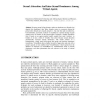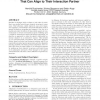121 search results - page 14 / 25 » Affective Model for Intelligent Virtual Agent Based on PFCM |
IUI
2004
ACM
14 years 23 days ago
2004
ACM
In this paper, we describe a method for pedagogical agents to choose when to interact with learners in interactive learning environments. This method is based on observations of h...
MABS
2000
Springer
13 years 11 months ago
2000
Springer
In many group-living primates, males are dominant over females, but despite this dominance, they allow females access to resources during the period when females are sexually attra...
ATAL
2010
Springer
13 years 8 months ago
2010
Springer
Speakers in dialogue tend to adapt to each other by starting to use similar lexical items, syntactic structures, or gestures. This behaviour, called alignment, may serve important...
IVA
2009
Springer
13 years 11 months ago
2009
Springer
In human-human conversation, the
first impression decides whether two people feel attracted by each other and whether contact between them will be continued or not. Starting from ...
DALT
2009
Springer
13 years 10 months ago
2009
Springer
Abstract. Virtual characters in games operate in a social context involving other characters and human players. If such socially situated virtual characters are to be considered be...



